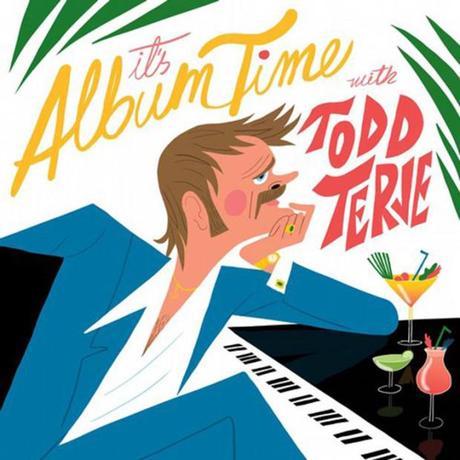

In the wake of Röyksopp’s early 00′s success with “Eple”, Norway – a country mostly associated with various forms of metal – spawned a whole new generation of confident young producers with strong affinities for Jean Michel Jarre, Giorgio Moroder and 70’s styled prog disco. At the forefront were Hans-Petter Lindstrøm and Prins Thomas, who understood the album format as a way of bridging styles and crossing over. Between the two of them, they created some of the most memorable dance albums of the last decade – 2005’s Lindstrøm & Prins Thomas and 2006’s It’s A Feedelity Affair – plus a series of A-list 12”s and high profile remixes. These guys were far from alone, and together with a handful more Norwegian producers mining similar retro-futuristic grounds, it eventually evolved into a whole scene of whimsical, playful disco-inspired electronica, commonly referred to as ‘space-disco’.
By appearance, the oddest and un-coolest of the bunch was a certain mustache-decorated Todd Olsen, better known as Todd Terje. His early single “Eurodans” showed why he often was referred to as the “King of summer jams” and the third leg of the “Holy Trinity of Norwegian disco”. But for the most part of the 00’s, Terje - who’s stage name is a comic twist on 90’s mega-dj Todd Terry – was content with producing and remixing other artists rather than putting out work with his own name attached. Then came “Snooze 4 Love” and absolutely heavenly “Inspector Norse”, both heavily endorsed by Pitchfork and the blogging community, and the task was handed to Terje to turn space-discos declining interest around. As his former space-disco patrons started wondering off in all sorts of direction, Terje continued steadily to carve out a singular space of his own. Like that of Lindstrøm and Prins Thomas, this space is occupied by 80’s synth-based soundtracks and Moroder-styled bass lines, but there is also something substantially more sanguine – bordering cheesy – about his music that sounds almost annoyingly effortless.
So a decade after “Eurodans”, Todd Terje finally assembled a full album. Enfolding one thirds of recycled material and two thirds new, It’s Album Time is a savory dip into every style and direction Terje toyed with in the past. Cheeky lashes into latino-jazz, calypso, cheesy piano house, italo-disco and strains of lounge music you’d normally find on some free-of-charge chill-out compilation – all stitched together into the most hedonistic and life-affirming dance album I’ve ever heard. Despite that a handful of songs are well known by now, they breathe of fresh life in their new context. The first songs you’re likely to recognize is “Strandbar” that follows the weirdest and most playful track on the album; the beat-less crack-pot calypso of “Svensk Sas” (Swedish sauce). And while the contrast between the two is miles apart, they are discretely held together by Terje’s imaginative humor and sinless enthusiasm. “Strandbar” is brilliantly eased into “Delorean Dynamite” that brings swarms of melodic drones, Moroder-esque bass lines, Patrick Cowley disco, and when a Niles Rogers-styled guitar makes its appearance; “Delorean Dynamite” even surpasses “Inspector Norse” as the albums most effervescent dance anthem. After that, the romantic ballad of “Johnny and Mary” serves as a welcomed comedown. It’s the albums least representative song – an early 80′s cover of a Robert Palmer single featuring art-disco legend Bryan Ferry on vocals – but it’s a showpiece in its own right. It’s a tender, bittersweet moment that fumes with confidence. It shows off Terje as a pop architect and explains why Robbie Williams and Franz Ferdinand are on his roaster of artists he produced. I’m guessing his phone won’t stop ringing any time soon.
As wonderful as the first half of the album is, the second is, if possible, even stronger. After the sassy prog-house of “Alfonso Muskedunder”, follows a quartet of Terje’s trademarked hypnotic space-disco. It’s The Arps allusive highlights “Swing Star Pt.1” and “Swing Star Pt.2” makes a reappearance in a somewhat denser version. The Ed Banger-worthy “Oh Joy” follows, and since It’s Abum Time more or less comes from the same place as Daft Punk’s Random Access Memories, it’s fitting that the majestic “Oh Joy” should bear some quiet resemblance to “Contact”, the closing track on RAM. And even if “Oh Joy” would’ve made an equaly brilliant finale, Terje chooses to end with the two year’s old “Inspector Norse”, perhaps the only time he miscues the albums otherwise cohesive feel. But talking about ending on a high note; it’s Terje’s testimony to disco hedonism, the track he forever will be linked to.
Commonly when dance music artists get around making an album spawned by a handful of successful singles, the rest of the tracks tend to be no more than meager fillers. But on here the so called “fillers” serves as clever, often startling, bridges between the clear highlights. As the title suggest, Terje has created analbum- not a best-of compilation or – as so often the case with dance music producer – anattemptat an album. You won’t find any self-indulging pretensions on here, only an uplifting, cohesive work by one of dance music’s most unlikely super heroes.. And as much as this is the party album of party albums – and hell, the holy trinity of “Delorean Dynamite”, “Oh Joy” and “Inspector Norse” makes me fall madly in love with dance music all over again –It’s Album Timeis also full of subtle revelations and savvy melancholia showing that, despite thehilarious promo photos, the album title and all the genuine playfulness that personifies Terje’s quirky sense of humor, there’s a whole lot more than meets the eye. You can easily understand the amount of thought and hours gone into these set of songs,and It’s Album Time’sgenuine style isn’t easily replicated. For me, It’s Album Time is up there amongst Random Access Memories and John Talabot’s Fin as one of recent year’s finest dance albums.

